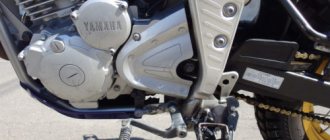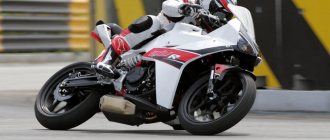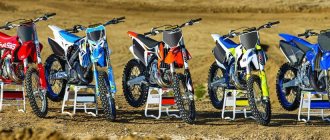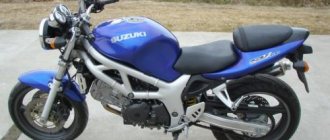The Yamaha XJR 400 is a classic road motorcycle, distinguished by its reliability and simplicity of design. Produced between 1993 and 2007. During this time it has undergone several modifications (3 generations).
The road worker is equipped with a 400 cc air-oil-cooled engine. see, manual 6-speed gearbox, OHLINS shock absorbers, Brembo brakes. This model is especially popular in the Japanese domestic market. The secret of success lies in its reliability and relatively low price.
The XJR 400 R is perfect for everyday trips around the city and for covering medium distances up to 500 km.
This motorcycle is a workhorse that copes with its tasks perfectly, requires a minimum of effort and maintenance costs, and most importantly does not let you down in difficult times and makes its rider happy every day.
The closest competitors are Honda CB 400 Super Four, Suzuki Bandit 400.
Peculiarities
The Yamaha XJR 400 was released between 1993 and 2009; the motorcycle was initially aimed at the Japanese market. The car did not gain much popularity in our country, although it did not cause any particular complaints. There are some shortcomings. However, there are plenty of advantages.
The layout of the power unit includes an air cooling system, which significantly simplifies the design, reducing maintenance costs and increasing overall reliability. Among the disadvantages are noise during engine operation and increased temperature conditions. The seat is moderately wide and not hard, providing sufficient riding comfort. The straight seating position along with the high steering wheel creates good conditions for the driver. Excellent visibility is ensured by mirrors that are practically not subject to vibration distortion.
Brief history of the model
1993 - start of production and sales of the model. Model: Yamaha XJR400 (Japan). Factory designation: 4HM1.
1994 - The model receives Ohlins rear suspension as standard and other engine tweaks that increase torque from 34.3 Nm to 38.2 Nm. The letter S is added to the model name. Model: Yamaha XJR 400S (Japan). Factory designation: 4HM2.
1995 - The model receives new 4-piston Brembo front calipers (gold) and adds the letter R to the name instead of S. Model: Yamaha XJR 400R (Japan). Factory designation: 4HM3, 4HM4.
1996 - appearance of the R2 modification. No significant changes. Model: Yamaha XJR 400R, Yamaha XJR 400R2 (Japan). Factory designation: 4HM5, 4HM6, 4HM7.
1997 - model not produced.
1998 - Starting this year, the model receives a 20 liter fuel tank (instead of 18 liters) and a new dashboard. This year's models feature a silver engine. Model: Yamaha XJR 400R (Japan). Factory designation: 4HM9.
1999 - no significant changes. A new black color appears. Black models, in addition to the engine and basic coloring, are distinguished by a black muffler. Model: Yamaha XJR 400R (Japan). Factory designation: 4HMA, 4HMB.
2000 - no significant changes. A new white color appears. White models are distinguished by a black engine and exhaust. Model: Yamaha XJR 400R (Japan). Factory designation: 4HMC, 4HMD.
2001 - The model receives new blue Nissin Sumitomo calipers from the first generation Yamaha R1. Model: Yamaha XJR 400R (Japan). Factory designation: 4HME.
2002 - no significant changes. Model: Yamaha XJR 400R (Japan). Factory designation: 4HMF.
2003 - no significant changes. Model: Yamaha XJR 400R (Japan). Factory designation: 4HMG.
2004 - The model changes the exhaust system and ignition settings to increase torque in the low and mid-range. Starting this year, the motorcycle is equipped with an immobilizer. Model: Yamaha XJR 400R (Japan). Factory designation: 4HMH.
2005 - no significant changes. Model: Yamaha XJR 400R (Japan). Factory designation: 4HMJ.
2006 - no significant changes. Model: Yamaha XJR 400R (Japan). Factory designation: 4HMK.
2007 - no significant changes. Model: Yamaha XJR 400R (Japan). Factory designation: 4HML.
2008 is the last year of production. Model: Yamaha XJR 400R (Japan). Factory designation: 4HMM.
Suspension
This block can hardly be called ideal. Especially when you consider that it is not provided for domestic highways. Therefore, you should drive the equipment more carefully. The unit is made in a budget version and consists of a standard telescopic fork at the front and two rear shock absorbers.
Although the fork has no adjustments, it behaves quite decently (just in case, it is better to use thick oil). With an extreme driving style, the part works on the verge of breakdown, not to mention driving with a passenger. In addition, the behavior of the suspension is manifested by not very good handling when cornering.
Chassis and brakes
The bike's hard saddle will not please those who like long journeys, for whom, however, the machine is not designed at all. The brakes are far from the most reliable, because the rear is equipped with a drum version. As for the suspensions, they are stiff and simple, which is good for a light city bike, which is what the SR400 is.
When talking about the chassis, we can’t ignore the exterior. Beautiful appearance, full of chrome and noble black color - this is what is best remembered about the model. Of course, the neat spoked wheel rims along with the equally elegant mechanisms at the bottom of the bike do not escape the eye.
Technical characteristics of Yamaha XJR 400
Below are the rest of the motorcycle's performance characteristics:
- The cylinder diameter and piston stroke in millimeters are 55/42.
- Fuel supply - carburetor.
- Gearbox – six steps.
- Drive – chain.
- Frame material – steel.
- Front/rear tires - 110/70 and 150/70 R-17.
- Fuel tank capacity – 18 liters.
- Maximum speed – 180 km/h.
- Acceleration from “zero” to “hundreds” – 5 seconds.
- Dry/curb weight – 175/195 kg.
Engine
The SR400, of course, is not intended for racing tracks or generally for dynamic, fast driving. Therefore, a single-cylinder air-cooled engine is enough for him. Until 2010, a carburetor was used, but after that it was replaced by an injector. A top speed of 128 km/h is what 27 hp can achieve. power and 27 Nm of torque.
Modifications
During the release of the Yamaha XJR 400 (cafe racer) motorcycle, several generations have changed. Among them:
- The first modification of the XJR 400. Production began in 1993.
- In the second generation, the letter R was added to the name; the bike differs from its predecessor in the presence of golden calipers (1996).
- The design of the instrument panel has changed. The number 2 appeared in the designation (1998).
- In the next generation, the name has the number 3, the model is distinguished by new Nissan Sumitomo brake calipers (2001).
- In 2009, the era of the motorcycle in question under the code XJR 400 ends.
Approximate prices for Yamaha XJR400
This “four hundred” in good condition can be purchased for 100-120 thousand rubles. On average, prices for this model vary from 65 thousand rubles. for a “killed” copy of the 1st-2nd generation and up to 170 thousand rubles for the latest generation XJR 400 R.
Conclusion: an unpretentious road bike with good ride quality, excellent brakes and a huge gas tank. Technically, it does not require special attention and care, so it is ideal for a beginner.
Test Drive
On the road, the two-wheeled car behaves confidently. If you accelerate the equipment over 100 km/h, the lack of wind protection immediately makes itself felt. This problem can be solved by installing the front guard yourself or in a workshop.
The suspension unit is quite good - fans of a non-aggressive driving style will appreciate it. This is due to the fact that the four hundredth Yamaha, like its predecessor the XJR 1300, has good dynamics and comfort. However, it is not very suitable for sharp maneuvers, precisely because of the presence of a soft suspension. And on our roads, a bike, especially with a passenger, will sag all the way.
The braking system of a motorcycle commands great respect. It works quickly and accurately. Even high-power analogues do not always have double-disc brakes. The motorcycle in question has a similar system as standard.
Dimensions and weight
Like many representatives of the past era, the motorcycle has average dimensions: its weight without fuel is small and amounts to approximately 160 kg, a 12-liter gas tank is more than enough with a consumption of 3 liters per hundred, and the seat height of 785 mm makes the bike suitable for people short in stature. All this makes the SR400 an excellent choice for a town with narrow streets.
Yamaha XJR 400 Reviews
Users share their impressions about this motorcycle in their responses. Among the advantages and features, they note the following points:
- Good acceleration and dynamics.
- Compared to liquid cooling, the atmospheric system is simpler in design.
- Excellent brakes.
- Wide, comfortable seat, ideal for moving around the city.
- Acceptable fuel consumption compared to its closest competitors (about six liters per 100 km).
- Low noise floor.
Among the disadvantages:
- The device is massive and too heavy for girls.
- Not very modern appearance.
- No center stand.
- Low position of the muffler.
- You won’t be able to drive quickly over bumps (it’s a bit rough).
For those who like to contribute to the design of equipment, there is the possibility of tuning. For example, by repainting the body in original colors or changing the configuration of the front fairing. As for the rest of the impressions, they are quite positive - the unit is unpretentious in maintenance and, with proper care, will last quite a long time, not inferior in almost anything to its more powerful competitors.
To conclude the review
The Japanese motorcycle Yamaha XJR 400, the characteristics of which are indicated above, has shown itself quite worthy in the relevant market. Of course, it is more suitable for Japanese roads than for domestic potholes. However, owners from post-Soviet countries have practically no complaints about the car; they find many more advantages in it than negative features. The transport appealed not only to novice motorcyclists, but also to experienced bikers who know how to squeeze out of this balanced “iron horse” everything it is capable of, and even a little more.









